#black american history
Photo


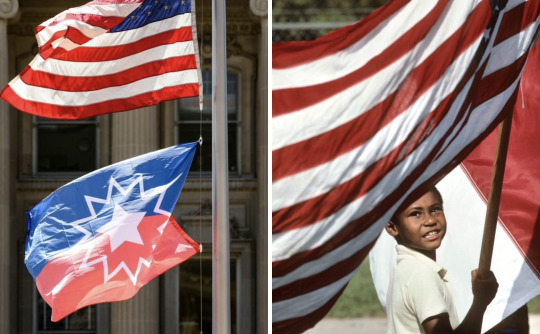


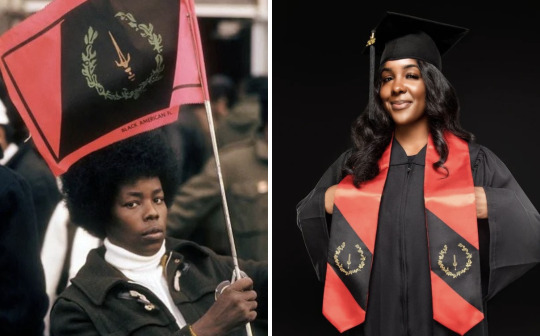
Juneteenth is a Black American holiday.
We call Juneteenth many things: Black Independence Day, Freedom Day, Emancipation Day, Jubilee Day. We celebrate and honor our ancestors.
December 31 is recognized as Watch Night or Freedom’s Eve in Black American churches because it marks the day our enslaved ancestors were awaiting news of their freedom going into 1863. On January 1, 1863, President Lincoln issued the Emancipation Proclamation. But all of the ancestors wouldn’t be freed until June 19, 1865 for those in Galveston, Texas and even January 23, 1866 for those in New Jersey (the last slave state). (It’s also worth noting that our people under the Choctaw and Chickasaw Nations wouldn’t be freed until April 28, 1866 and June 14, 1866 for those under the Cherokee Nation by way of the Treaties.)
Since 1866, Black Americans in Texas have been commemorating the emancipation of our people by way of reading the Emancipation Proclamation and coming together to have parades, free festivities, and later on pageants. Thereafter, it spread to select states as an annual day of commemoration of our people in our homeland.
Here’s a short silent video filmed during the 1925 Juneteenth celebration in Beaumont, Texas:
youtube
(It’s also worth noting that the Mascogos tribe in Coahuila, Mexico celebrate Juneteenth over there as well. Quick history lesson: A total of 305,326 Africans were shipped to the US to be enslaved alongside of American Indians who were already or would become enslaved as prisoners of war, as well as those who stayed behind refusing to leave and walk the Trail of Tears to Oklahoma. In the United States, you were either enslaved under the English territories, the Dutch, the French, the Spanish, or under the Nations of what would called the Five “Civilized” Native American Tribes: Cherokee, Creek (Muscogee), Chickasaw, Choctaw, and Seminoles. Mascogos descend from the Seminoles who escaped slavery during the Seminole Wars, or the Gullah Wars that lasted for more than 100 years if you will, and then settled at El Nacimiento in 1852.)
We largely wave our red, white and blue flags on Juneteenth. These are the only colors that represent Juneteenth. But sometimes you may see others wave our Black American Heritage flag (red, black, and gold).
Juneteenth is a day of respect. It has nothing to do with Africa, diversity, inclusion, immigration, your Pan-African flag, your cashapps, nor your commerce businesses. It is not a day of “what about” isms. It is not a day to tap into your inner colonizer and attempt to wipe out our existence. That is ethnocide and anti-Black American. If you can’t attend a Black American (centered) event that’s filled with education on the day, our music, our food and other centered activities because it’s not centered around yours…that is a you problem. Respect our day for what and whom it stands for in our homeland.
Juneteenth flag creator: “Boston Ben” Haith
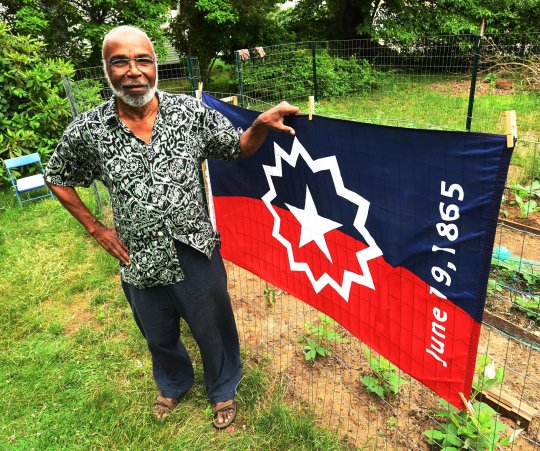
It was created in 1997. The red, white and blue colors represent the American flag. The five-point star represents the Lone State (Texas). The white burst around the star represents a nova, the beginning of a new star. The new beginning for Black Americans.
Black American Heritage Flag creators: Melvin Charles & Gleason T. Jackson

It was created in 1967, our Civil Rights era. The color black represents the ethnic pride for who we are. Red represents the blood shed for freedom, equality, justice and human dignity. Gold fig wreath represents intellect, prosperity, and peace. The sword represents the strength and authority exhibited by a Black culture that made many contributions to the world in mathematics, art, medicine, and physical science, heralding the contributions that Black Americans would make in these and other fields.

SN: While we’re talking about flags, I should note that Grace Wisher, a 13-year-old free Black girl from Baltimore helped stitched the Star Spangled flag, which would inspire the national anthem during her six years of service to Mary Pickersgill. I ain’t even gon hold you. I never looked too far into it, but she prob sewed that whole American flag her damn self. They love lying about history here until you start unearthing them old documents.
In conclusion, Juneteenth is a Black American holiday. Respect us and our ancestors.
#juneteenth#juneteenth flag#black american history#black american culture#ben haith#black american heritage flag#melvin charles#gleason t jackson#grace wisher#american flag#mascogos#juneteenth 2023
1K notes
·
View notes
Text
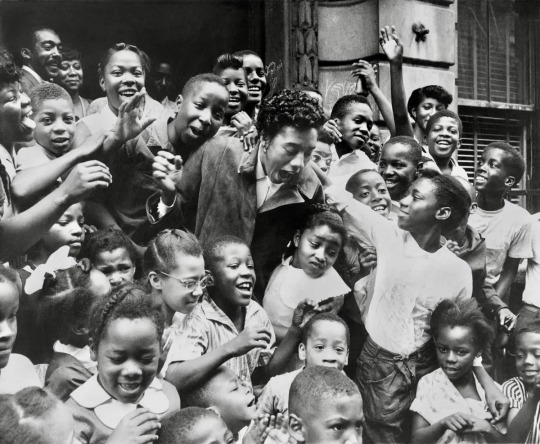
Neighbourhood children greet Ms. Gibson upon her return to Harlem after winning Wimbledon in 1957
#althea gibson#tennis#sports#history#american history#black american history#black history#currently reading carefree black girls by zebra blay and her picture was before the first essay#and you KNOW I love research
891 notes
·
View notes
Text
Bayard Rustin
Back when I was working as an archivist at the American Jewish Historical Society at the Center for Jewish History in Manhattan, one of the most interesting figures I had the pleasure of learning about was proudly and publicly gay Civil Rights activist, advisor to Dr. Martin Luther King, and firm believer in the importance of Black and Jewish American communal solidarity: Bayard Rustin.

Bayard Rustin standing on a stage and speaking to a crowd from a podium at the 1967 NAACP Conference in Albany, New York. Image courtesy of the NMAAHC.
Check out the small, but fascinating collection here! The Schomburg Center for Research in Black Culture highly recommends this study of Mr. Rustin, and the NMAAHC has a fantastic bio here, with a link to further collections materials. I also highly recommend taking a look at some of the photos and related collections held by the Library of Congress.
As some of you may know, a well-received biopic of this fascinating figure was recently released. And incidentally, my dear friend and DC-based actor, Emily Gilson, had a small, but impactful role in the film as "Little Rock White Girl."
Check it out! Or at least, check out some of these fantastic collections.
99 notes
·
View notes
Text

The Social Security Act, signed on this day in 1935, provided retirement and unemployment benefits to Americans, but it didn’t include farm and domestic workers, who were disproportionately Black. This kept nearly two-thirds of Black workers out of the program.
Learn more in our current special exhibition: BLACK AMERICANS, CIVIL RIGHTS, AND THE ROOSEVELTS: https://fdrlibrary.org/civil-rights-special-exhibit
Photo: Domestic workers march to demand inclusion in the Social Security program and New Deal legislation establishing a national minimum wage. (c) Joe Schwartz Photo Archive
129 notes
·
View notes
Text
Women's History Month

Dr. Angela Davis (American, b. 1944) • Feminist activist, philosopher, author, and academic.
"Feminism is the radical notion that women are human beings." – Angela Davis
#notable american woman#woman author#woman philosopher#women's history month#angela davis#women's history#feminist#feminism#pagan sphinx art blog#woman activist#black american history
44 notes
·
View notes
Text
53 years ago the Stonewall Uprising sparked a new wave of Queer resistance. June is observed as LGBTQIA+ Pride Month to commemorate this day, continue advocating for the essential humanity of all people, and recognize the many contributions of Queer people.
Learn more with Crash Course Black American History
87 notes
·
View notes
Text

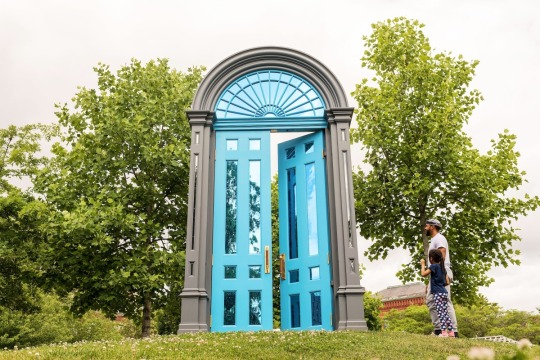
Mark Reigelman, “Threshold” (2023)
“Threshold” by sculptor Mark Reigelman will be a public artwork celebrating the principles of equality and community-building that have been integral to the history of New Bedford. Inspired by the Religious Society of Friends (Quakers) who inhabited the city in the late 17th century as well as the aesthetic of New England’s archetypal colonial doorways, Mark Reigelman beckons viewers toward Threshold’s partially opened door, shining down on Custom House Square from its 17-foot-tall perch.
Threshold will draw on the unique architecture of the federal doorway of the oldest building in New Bedford’s Abolition Row Historic District, constructed mainly from wood and steel, an important site in the early Black freedom struggle. Its double-sided door references the community’s diverse history, with its blue façade facing the Wharf and rising sun as a nod to the city’s fishing roots. At the same time, its massive arched window is tiled with colorful mirrored pieces, capturing the various identities and cultures that have made up the city.
#art#design#doorway#architecture#heavensdoorways#doors#doorsdesign#doordesign#entrance door#new bedford#quakers#new england#mark reigelman#black freedom#black lives matter#american history#black american history
58 notes
·
View notes
Text
38 notes
·
View notes
Video
youtube
A Black People's History of Parties
#youtube#lexual media#harlem renaissance#black american#black american culture#black americans#house party#black american history#freaknik#rent parties#black american heritage#jook joint#juke joint#cross bronx expressway#voguing#vogue dance#bronx block parties#Po' Monkey's#Blue Front Cafe#Jimmy Duck Holmes
39 notes
·
View notes
Text
One of my paternal great-grandfathers used to smuggle moonshine inside coffins back in the day, and every time I hear the line in American Requiem about a moonshine man, I giggle, like yeah, our great grandpappys took risks to survive. Fuck this country. All day every day.
7 notes
·
View notes
Text
Hey, just curious, but do any of ya’ll think there is a term for Black Americans whose ancestors were slaves? Because if not, I think there should be. This is all from my experience as an American who has not gotten to travel abroad. This post is specific to the US, as I cannot lump all nations’ experiences with this topic together.
Black Americans have forged a bit of a shared identity and community due the deep rooted aspects of race present in American society. Whether a Black American is a descendant of slaves, they are still impacted by racism in this country. However, a bit ago, I remember hearing someone talk about how they were talking with a group of Black college students having a discussion on race in America.
A couple of these students were not descendants of American slaves, and were instead Caribbean American. Also when the topic of slavery came up, there were very different perspectives due to the very different experiences both groups had. The thing is, the Caribbean American students were fully connected to their cultural roots, and had an easier time tracing back their ancestry. Meanwhile, Black Americans descended from slaves (like myself) have a culture of sorts, but we are also often unsure as to which cultures our ancestors came from. There is a feeling of sadness and a very specific generational trauma from knowing what happened to our ancestors.
We are unified in our Blackness, but some of us have very different relationships to race and Blackness in American and our country’s history with slavery. Some are more directly connected to it than others, while some bare very different generational trauma tied to their cultures. Both types of experiences are valid, but extremely different when it comes to the topic of history.
I feel like there should be a term that can be used to specifically refer to Black Americans who are descended from slaves, as that could be important context in conversations like these.
Does anyone get what I mean?
#black#black americans#african american#black culture#black history#american history#racism#black american history#race#discussion#black experience#diversity#american slavery#slavery in america#blackness#being black#african america history#ancestry#heritage#black heritage#cultural heritage
8 notes
·
View notes
Text

Pink Anderson (1900-1974)
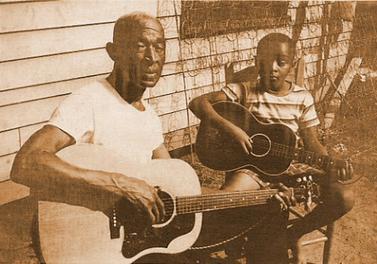
Pink Anderson was a historic figure whose music included Piedmont-style blues, folk music, ragtime, and traditional ballads. He was born in South Carolina and early on sang in the streets for pennies. He was self-taught as a guitarist and toured throughout the Southeast with a variety of medicine shows (including Dr. William R. Kerr's "cure all medicine") during 1915-1945, picking up work wherever he could. He was employed not only as a musician and a singer but as a dancer and comedian.
Anderson recorded four titles in 1928 but did not make another record until Harlem Street Spirituals in 1950 for Riverside. At that time he recorded such traditional folk material as “John Henry,’ ‘The Ship Titanic,” and “Wreck of the Old 97.” He continued to work at parties, street fairs, and medicine shows during the first half of the 1950s before retiring for a time due to ill health. But in 1961, the Bluesville label recorded three albums of unaccompanied performances by Anderson, documenting him in Spartanburg, South Carolina. The titles of the three records, Carolina Blues Man, Medicine Show Man, and Ballad & Folksinger, vol. 3, sum up Pink Anderson’s life well and are a large slice of the repertoire that he had performed during the previous 35 years.
Pink Anderson stayed active on a part-time basis up until the time of his death in 1974. His music represents the Carolina blues, and the tradition of the constantly traveling folk singer.
Source
Floyd Council (1911-1976)
Floyd Council was a blues singer and guitar slinger who played in the East Coast / Piedmont style. He didn’t record solo often, but he’s still said to have recorded 27 songs, many backing up the legendary Blind Boy Fuller.
Born in North Carolina, Floyd began his musical career on the streets of Chapel Hill in the 1920s, performing with two brothers, Leo and Thomas Strowd as “The Chapel Hillbillies.” He recorded twice for ARC at sessions with Blind Boy Fuller in the mid-thirties, all examples of the Piedmont style. He was sometimes promoted as ‘Dipper Boy Council’, and ‘The Devil’s Daddy-in-Law,’ but these were likely the invention of record companies, not genuine nicknames.
Council suffered a stroke in the late 1960s which partially paralyzed his throat muscles and slowed his motor skills, but did not significantly damage his cognitive abilities. Folklorist Peter B. Lowry attempted to record him one afternoon in 1970, but he never regained his singing or playing abilities. Accounts say that he remained “quite sharp in mind.” Council died in 1976 of a heart attack, after moving to Sanford, North Carolina.
Source
Pink Floyd

Pink Anderson and Floyd Council were both featured on a Blind Boy Fuller album called Country Blues: 1935-1940. The sleeve of that album caught the eye of Syd Barrett, the frontman for London band, The Tea Set. Barrett changed the band's name to Pink Floyd, and the rest is history.
Source
#pink anderson#floyd council#blind boy fuller#syd barrett#pink floyd#piedmont blues#black american history#music history#thechanelmuse trivia
303 notes
·
View notes
Text
PBS' Zora Neale Hurston: Claiming a Space
#Zora Neale Hurston#Cudjo Lewis#Oluale Kossola#Black American History#Black History#American History#BAVE#Black American Vernacular#Southern dialect#Black language#anthropology#ethnography#Southern Negro dialect#language#speech
24 notes
·
View notes
Text
"Rhythm and blues was too good to remain a black secret for long and as the fifties dawned, certain musically adventurous white DJs started to add it to their playlists. By 1956 a quarter of the best-selling US records would be by black singers. This move was accelerated by the dramatic commercial success of some of the new black stations, exemplified by WDAI in Memphis - since 1948 the first black-owned radio station - which, as well as being home of DJs BB King and Rufus Thomas (he of the 'Funky Chicken'), was extremely profitable.
In adopting this subversive music, white DJs also started adopting black slang. This 'broadcast blackface', as Nelson George calls it, let them speak (and advertise) to both the black community and younger whites. Dewey Phillips of Memphis's WHBG was so successful at integrating his audience that the wily Sam Phillips of Sun Records chose him to broadcast Elvis Presley's first single.
The idea of the 'white negro' was still born of racism, however. George recounts the amazing tale of Vernon Winslow, a former university design teacher with a deep knowledge of jazz, who was denied a radio announcing job on New Orleans' WJMR simply because he was black. After what seemed like a successful interview, Winslow, who was quite light-skinned, was asked, 'By the way, are you a nigger?' Denied an on-air job merely because of his race, Winslow was hired for a most extraordinary job. He was to train a white DJ to sound black. Winslow had to feed a white colleague - now christened Poppa Stoppa - with the latest local slang, teaching him to say things like 'Look at the gold tooth, Ruth' and 'Wham bam, thank you ma'am'. The show became a smash. One night, frustrated by his behind-the-scenes existence, Winslow snuck a turn at the mic. He was fired immediately. WJMR kept the Poppa Stoppa name and continued using a white man, Clarence Hamman, to provide Poppa's voice. (Winslow had his revenge, though, as Doctor Daddy-O on New Orleans' WEZZ where he would become one of the country's top ten DJs.)"
- excerpt from Last Night a DJ Saved My Life by Bill Brewster and Frank Broughton
#black american history#dj history#dj tag#music history#radio history#racism#new orleans history#black music history#vernon winslow#book im reading right now
10 notes
·
View notes
Text
BLACK WOMEN IN THE WARTIME STRUGGLE
Black women were on the frontlines of civil rights activism during the war years.
The grassroots organizing work of young leaders like Juanita Jackson, Ella Baker and Rosa Parks helped fuel a dramatic increase in NAACP membership and branch activism. Union organizers like Dollie Lowther Robinson and Maida Springer labored to ensure workers’ rights. Black women also engaged in direct-action protests against segregation like Pauli Murray’s 1940 arrest for sitting in the whites-only section of a bus in Virginia.



Grassroots organizers Juanita Jackson, Ella Baker, and Rosa Parks helped the NAACP grow dramatically during the war.
- https://www.mdhistory.org/resources/jackson-and-mitchell-family-portrait/
- https://www.loc.gov/pictures/item/94504496/
- https://www.loc.gov/pictures/item/2015647352/
More than half a million Black women left farm and domestic work for better-paying jobs in wartime shipyards and defense factories. But they had to struggle against employers who refused to hire Black women (or confined them to menial jobs) and white employees who resisted working alongside them.
Black women also overcame determined opposition to enter the armed services. Mary McLeod Bethune served as a special assistant in the War Department and worked with the National Council of Negro Women and Eleanor Roosevelt to open the Women’s Army Corps (WAC) to Black recruits. Eventually, 6,500 served. Bethune also lobbied successfully for officer appointments. Still, Black WACs served in segregated units and were often assigned low-skilled work. The Army also limited the number of Black nurses and restricted them to segregated hospitals. Conditions in the Navy were even worse. Secretary of the Navy Frank Knox opposed the entry of Black women into the service’s women’s auxiliary (WAVES). They were only admitted after his death in 1944.

Major Charity E. Adams inspects a Women’s Army Corps (WAC) battalion in England, February 15, 1945 (https://catalog.archives.gov/id/531249)
African American women also took on the then taboo subject of sexual violence. Sexual assaults on Black women by white men were a parallel offense to the lynchings of Black men. A 1944 Alabama rape case involving Recy Taylor sparked an NAACP investigation by Rosa Parks and widespread publicity. The Committee for Equal Justice, organized by Parks, led a national protest drive to bring the seven, armed white rapists to justice. Its allies included the Southern Negro Youth Congress (SNYC), described by historian Erik McDuffie as “the shock troops for Black equality across the Jim Crow South during the war.” The SNYC conducted wartime campaigns for desegregation and voting and labor rights. Its leadership included women like Rose Mae Catchings and Sallye Bell Davis, mother of activist Angela Davis.
Please visit our current special exhibition BLACK AMERICANS, CIVIL RIGHTS, AND THE ROOSEVELTS, 1932-1962: https://www.fdrlibrary.org/civil-rights-special-exhibit
#women's history month#rosa parks#Juanita Jackson#Ella Baker#Recy Taylor#wwii#world war ii#1940s#ww2#black american history#american history
11 notes
·
View notes
Text

Nella Larsen’s application to library school
#nella larsen#library school#history#black history#black american history#passing is probably one of my favourite books of all time and I recently finished Quicksand too!#honestly she’s so fascinating to me#wish there was more known about her life
4 notes
·
View notes